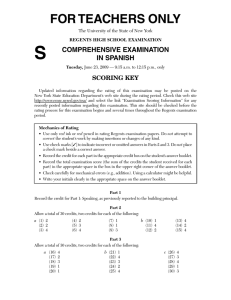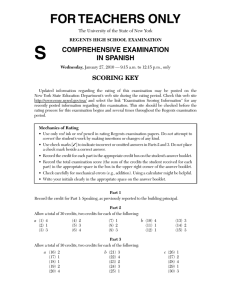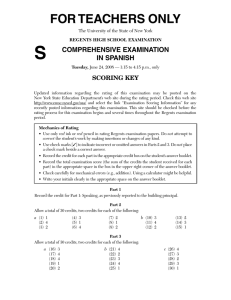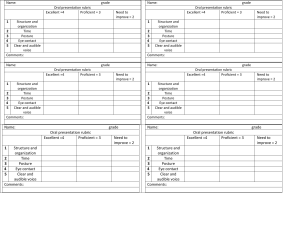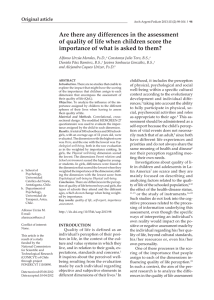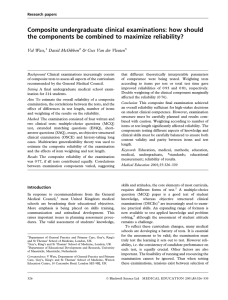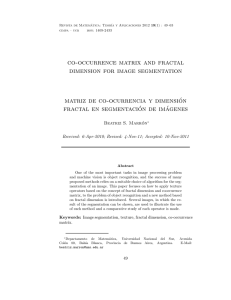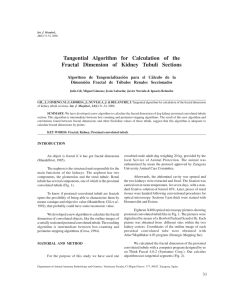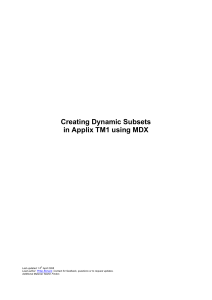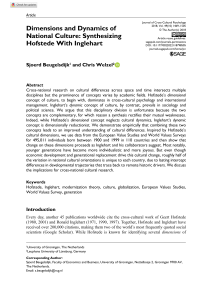Scoring Key
Anuncio
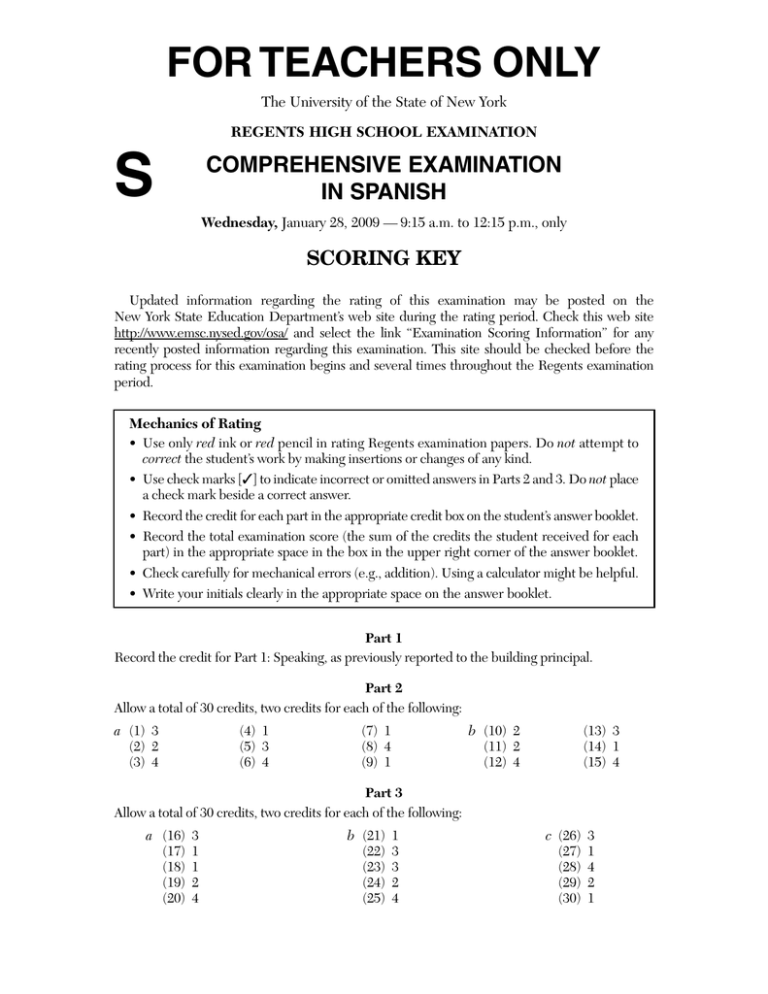
FOR TEACHERS ONLY The University of the State of New York REGENTS HIGH SCHOOL EXAMINATION S COMPREHENSIVE EXAMINATION IN SPANISH Wednesday, January 28, 2009 — 9:15 a.m. to 12:15 p.m., only SCORING KEY Updated information regarding the rating of this examination may be posted on the New York State Education Department’s web site during the rating period. Check this web site http://www.emsc.nysed.gov/osa/ and select the link “Examination Scoring Information” for any recently posted information regarding this examination. This site should be checked before the rating process for this examination begins and several times throughout the Regents examination period. Mechanics of Rating • Use only red ink or red pencil in rating Regents examination papers. Do not attempt to correct the student’s work by making insertions or changes of any kind. • Use check marks [] to indicate incorrect or omitted answers in Parts 2 and 3. Do not place a check mark beside a correct answer. • Record the credit for each part in the appropriate credit box on the student’s answer booklet. • Record the total examination score (the sum of the credits the student received for each part) in the appropriate space in the box in the upper right corner of the answer booklet. • Check carefully for mechanical errors (e.g., addition). Using a calculator might be helpful. • Write your initials clearly in the appropriate space on the answer booklet. Part 1 Record the credit for Part 1: Speaking, as previously reported to the building principal. Part 2 Allow a total of 30 credits, two credits for each of the following: a (1) 3 (2) 2 (3) 4 (4) 1 (5) 3 (6) 4 (7) 1 (8) 4 (9) 1 b (10) 2 (11) 2 (12) 4 (13) 3 (14) 1 (15) 4 Part 3 Allow a total of 30 credits, two credits for each of the following: a (16) (17) (18) (19) (20) 3 1 1 2 4 b (21) (22) (23) (24) (25) 1 3 3 2 4 c (26) (27) (28) (29) (30) 3 1 4 2 1 COMPREHENSIVE SPANISH — continued Part 4 In this part of the examination, students are asked to demonstrate the ability to write in the target language using the four functions of language (socializing, getting others to adopt a course of action, getting and providing information, and expressing personal feelings) as the vehicle for communication. Students are instructed to choose two of the three tasks provided and write a response of at least 100 words in the target language to achieve a specified communication purpose. A word is defined as a letter or collection of letters, surrounded by space, that in the target language is comprehensible and contributes to the development of the task. This definition applies even when words are grammatically incorrect. When counting words, please note that numbers, unless written as words, and names of people are not to be counted. Place names and brand names from the target culture count as one word (all other places and brand names are disregarded), and contractions are counted as one word. In addition, salutations and closings are counted, as well as commonly used abbreviations in the target language. Additional information concerning word count guidelines, how to apply the writing rubric, and use of the scoring rubric for students with disabilities who have a spelling exemption listed on an IEP or 504 plan is provided in the document, Comprehensive Regents Examination in Modern Foreign Languages Test Changes and Sampler Draft, which is available on the Department web site at http://www.emsc.nysed.gov/osa/lotegre/loterearch/lotesam.pdf. The responses to the Part 4 writing tasks must be written in the student’s own words; no credit should be given for a response that is copied or substantially the same as material from other parts of the examination. Part 4 is worth a total of 16 credits. Each response is worth a maximum of eight credits and must be rated according to the writing rubric for Part 4, which is provided on the next page. This writing rubric measures five dimensions: purpose/task, organization, vocabulary, structure/conventions, and word count. The dimensions of purpose/task, organization, vocabulary, and structure/conventions are measured on a zero to four scale; the dimension of word count is measured on a zero to two scale. A writing checklist is also provided for use in rating student responses. The writing checklist requires reference to the full writing rubric for the definitions of each dimension at each level and is not intended as a substitute for the writing rubric. After rating the student’s response for each dimension, the scores for the five dimensions must be added, resulting in a total raw score for the response. The conversion chart must be applied to that total raw score so that the proper credit is given to the student for the question. For example, if a student received a performance level score of 3 on the dimension of purpose/task, a score of 3 on the dimension of organization, a score of 2 on the dimension of vocabulary, a score of 3 on the dimension of structure/conventions, and a score of 2 on the dimension of word count, the student’s total raw score would equal 13 (the sum of the five performance level scores). According to the conversion chart, a raw score of 13 represents a converted score of 6 credits for the question. The conversion chart for Part 4 is shown below. Part 4 Conversion Chart Total Raw Score Total Credits 17–18 15–16 13–14 11–12 8 7 6 5 8–10 6–7 4–5 2–3 0–1 4 3 2 1 0 After each of the two questions has been scored, the two converted scores must be added together to determine the total Part 4 score. This total Part 4 score should be entered in the last box on the last page of the student answer booklet and also under the “Credit Earned” section for Part 4, on the upper right corner of the first page of the student answer booklet. [2] COMPREHENSIVE SPANISH — continued The writing rubric for Part 4 is shown below. Part 4 Writing Rubric Note that a zero can be given in any of the dimensions when the student’s performance falls below the criteria described for the performance level of 1. Performance Level 4 3 2 1 Purpose/Task Accomplishes the task; includes many details that are clearly connected to the development of the task, but there may be minor irrelevancies. Accomplishes the task; includes some details that are generally connected to the development of the task, but there may be some irrelevancies. Accomplishes the task; includes few details, some of which may be only loosely connected to the task. There are many irrelevancies. Attempts to accomplish the task; makes some reference to it but provides few or no supporting details. Organization The extent to which the response exhibits direction, shape, and coherence Exhibits a logical and coherent sequence throughout; provides a clear sense of a beginning, middle, and end. Makes smooth transitions between ideas. Exhibits a logical sequence; provides a beginning, middle, and end. Attempts to provide a logical sequence and/or the beginning or ending is abrupt or unclear. Exhibits little order; provides a series of separate sentences and/or disconnected ideas. Vocabulary Includes a wide variety of vocabulary that expands the topic, but there may be minor inaccuracies. Includes a variety of vocabulary related to the topic. Includes basic vocabulary; some vocabulary may be inaccurate or unrelated to the topic. Includes limited vocabulary and/or most vocabulary is inaccurate or unrelated to the topic. Structure/ Conventions • Subject-verb agreement • Tense • Noun-adjective agreement • Correct word order • Spelling/diacritical marks Demonstrates a high degree of control of Checkpoint B structure/conventions: • subject-verb agreement • present, past, future ideas expressed as appropriate • noun-adjective agreement • correct word order • spelling/diacritical marks Demonstrates some control of Checkpoint B structure/conventions: • subject-verb agreement • present, past, future ideas expressed as appropriate • noun-adjective agreement • correct word order • spelling/diacritical marks Demonstrates some control of Checkpoint B structure/conventions. Errors do hinder overall comprehensibility and/or there are numerous Checkpoint A errors. Demonstrates little control of Checkpoint A or B structure/conventions: • subject-verb agreement • present, past, future ideas expressed as appropriate • noun-adjective agreement • correct word order • spelling/diacritical marks Dimension Errors do not hinder Errors do not hinder overall comprehensibility overall comprehensibility of the passage. of the passage. Word Count — — [3] OR Demonstrates a high degree of control, but uses only Checkpoint A structure/conventions. Errors impede overall comprehensibility of the passage. Uses 100 or more comprehensible words in the target language that contribute to the development of the task. Uses 50–99 or more comprehensible words in the target language that contribute to the development of the task. [OVER] COMPREHENSIVE SPANISH — continued The writing checklist for Part 4 is shown below. Part 4 Writing Checklist Please refer to the full writing rubric for definitions of each level. Note that a zero can be given in any of the dimensions when the student’s performance falls below the criteria described for the performance level of 1. Question No. _____ Dimension 4 Performance Level 3 2 1 Question No. _____ 0 4 3 2 1 0 Purpose/Task • Accomplishes the task • Includes details • Connects ideas to task/purpose Organization • Exhibits a logical and coherent sequence • Has a beginning, middle, and end • Makes smooth transitions Vocabulary • Includes a variety of vocabulary • Uses relevant and accurate words Structure (degree to which errors hinder overall comprehensibility) • • • • • Subject-verb agreement Present, past, future ideas expressed as appropriate Noun-adjective agreement Correct word order Spelling/diacritical marks Word Count 100+ 50– <50 99 • Comprehensible • In target language 100+ 50– <50 99 This writing checklist is provided solely for the teacher’s convenience. This form is not required to be completed and should not be returned to the State Education Department. In addition, when scoring Part 4 responses, no marks should be placed on the student’s paper as such marks may interfere with the ability of the rater to properly apply the scoring rubric. [4] COMPREHENSIVE SPANISH — continued If a student’s response receives a performance level score of zero on the dimension of purpose/task, the entire response should receive a score of zero. Please note, however, that in order to receive a score of zero on the dimension of purpose/task, the student’s response must be completely unrelated to the topic. A student’s response must not be given a zero on the dimension of purpose/task if the response can be associated with the task in any manner whatsoever. In such an instance, the student’s response must be rated on each of the dimensions of the writing rubric. Part 4 A sample of an 8-credit response for each question in Part 4 follows: 31 ¡Imagínate! ¡No lo puedo creer! Mi mejor amiga me sorprendió anoche con una fiesta de cumpleaños. ¡Qué alegría! Me había invitado a su casa a ver un video nuevo. Cuando entré unas treinta personas me gritaron “Feliz Cumpleaños”. Me abrazaron y Ricardo me dio un besito en la mejilla. Había pizza y refrescos para todos y mi torta favorita, de chocolate y cerezas. Después de comer, charlamos y bailamos, y lo pasamos muy bien. Más tarde me ofrecieron unos regalos. Recibí ropa, dinero, CDs y unos aretes. Ricardo me dio una tarjeta en la cual me invitó a ir al cine con él el sábado próximo ¡Qué ilusión! Fue realmente un cumpleaños inolvidable. Voy a escribir mucho más después de mi cita el sábado. 32 Paco, Mi familia va a viajar a la Florida. Viajo con mis padres, hermanos, hermanas — ¡y el perro, también! Vamos la tercera semana de abril durante las vacaciones de primavera. Primero vamos al Mundo de Disney en Orlando. Hay mucho que ver y hacer en ese gran parque de atracciones. También sé que vamos a ver un partido de béisbol de las ligas mayores. Están entrenándose en abril y los boletos no son muy caros. Quizás podamos obtener unos autógrafos de los jugadores. Después de pasar un rato en el centro de la Florida vamos a ir a la costa y nadaremos en el mar. ¡Será muy divertido! Te contaré más cuando vuelva. tu amigo, Roberto 33 El Sr. Martínez es un negociante que trabaja en Madrid. Hoy va a almorzar en un restaurante cerca de su oficina. El problema es que no sabe mucho español y entonces no entiende toda la carta. No sabe que pedir. Cuando el camarero le pregunta qué le apetece, el Sr. Martínez explica que no entiende y que necesita ayuda. El camarero sabe algo de inglés y le dice que el plato del día es el pollo asado. También le explica que el plato del día no incluye el aperitivo, la bebida ni el postre. Aunque es un poco caro el Sr. Martínez decide pedir el pollo asado con papas y una ensalada verde. Va a beber el agua mineral, y el camarero le recomienda el flan como postre. Al Sr. Martínez le gustó mucho su comida. [5] [OVER] COMPREHENSIVE SPANISH — concluded Regents Comprehensive Examinations in Modern Languages Map to Learning Standards Key Ideas Part of Test/Item Numbers Speaking Part 1, Speaking Test (administered prior to the written test) Listening Part 2, Listening Comprehension Items: 1–15 Reading Part 3, Reading Comprehension Items: 16–30 Writing Part 4, Writing Items: 31–33 Culture Embedded in each item of test Submitting Teacher Evaluations of the Test to the Department Suggestions and feedback from teachers provide an important contribution to the test development process. The Department provides an online evaluation form for State assessments. It contains spaces for teachers to respond to several specific questions and to make suggestions. Instructions for completing the evaluation form are as follows: 1. 2. 3. 4. 5. Go to www.emsc.nysed.gov/osa/exameval. Select the test title. Complete the required demographic fields. Complete each evaluation question and provide comments in the space provided. Click the SUBMIT button at the bottom of the page to submit the completed form. [6]
